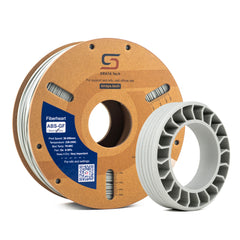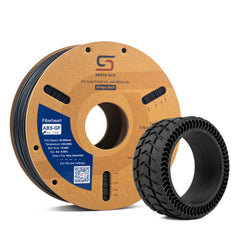Fibreheart ABS-GF Filament User Guide
1. Introduction to Fibreheart ABS-GF
Designed for hobbyists and professionals, this guide unlocks the potential of ABS-GF, blending ABS's robustness and temperature resilience with the ease of printing and reduced warpage courtesy of glass fiber infusion.
With a 10% glasskage and offering a smoother printing experience, it's the perfect match for applications demanding the highest ABS performance. The fiber composition, Fibreheart ABS-GF, minimizes odor and enhances print accuracy by reducing the shrine.


2. Preparing for Printing
(1) Printer Compatibility
Fibreheart ABS-GF is optimized for FDM printers equipped with direct drive extruders, which are located on the tool head for enhanced filament control. This setup is crucial for successful ABS-GF printing.
For best results, please mount the filament directly above the extruder to facilitate the shortest and most efficient path from the spool to the extruder, thus significantly enhancing the print quality and success rate.
(2) Print Bed Preparation
A clean, level print bed is essential. We recommend a heated bed temperature ranging from 100°C to 110°C, adjusted according to your printer’s capabilities.
(3) Enclosure
An enclosure is crucial for maintaining consistent printing temperatures, ideally around 50°C, to significantly reduce issues like warping and failure rates, particularly in cold climates.
3. Material Characteristics
Density: 1.08 g/cm³ (ISO 1183)
Hardness: 82D
Melt temperature: 250 ℃
Softening temperature: 106°C (ISO 306)
All numbers below are tested on X/Y axis
Tensile breaking strength: 44± 3.0 MPa (ISO 527)
elongation at break: 3%
4. Printing with Fibreheart ABS-GF
(1) Temperature Settings
Ideal extrusion nozzle temperatures range from 250°C to 270°C, varying with printer models and environmental factors.
(2) Print Speed
Thanks to its high-flow formulation, Fibreheart ABS-GF can be printed at speeds between 30-120 mm/s. Start at the lower end and gradually increase speed for optimal results.
(3) Nozzle
For printing Fibreheart ABS-GF, use a hardened steel or diamond-tipped nozzle to withstand the abrasive nature of glass fiber. While nozzles larger than 0.2mm work, a 0.4mm nozzle often yields the best results, ensuring long-term printing consistency and quality.
(4) Retraction Settings
To prevent clogging, keep retraction speeds between 1800-3600 mm/min and retraction distances within 1-5 mm. Start with short and slow retraction first.
(5) Build Platform Material
PEI or glass with glue stick application is recommended for best adhesion.
(6) Cooling Fan
Ensure the cooling fan is operational but running at low speed to maintain print quality. Users generally print at 0-30% fan speed. Adjust settings as needed for your specific printer.
5. Moisture Management
 ABS filaments, including Fibreheart ABS-GF, are prone to moisture absorption, which can adversely affect print quality. Effective moisture management is therefore crucial.
ABS filaments, including Fibreheart ABS-GF, are prone to moisture absorption, which can adversely affect print quality. Effective moisture management is therefore crucial.
(1) Storage: Store Fibreheart ABS-GF in the provided moisture-resistant aluminum bags when not in use. Using a dry box with desiccant, maintaining humidity below 15% is ideal for prolonged storage.
(2) Drying Filament: If moisture absorption is suspected, dry the filament at 65°C for 4-6 hours in a filament dryer or an oven.
6. Troubleshooting Common Issues
(1) Stringing: Adjust retraction settings and print speed to tackle stringing. Also, ensure the filament’s moisture level is within acceptable limits.
(2) Poor Bed Adhesion: Improve bed adhesion using a glue stick or hairspray, or by slightly increasing the bed temperature. Make sure the temperature is set to at least 100C, and an enclosure can greatly help with the results.
